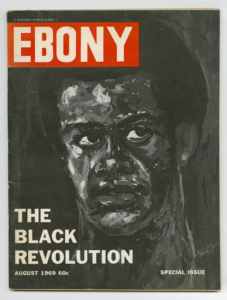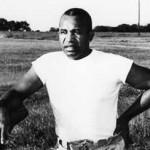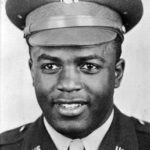Retracing Slavery’s Trail of Tears
America’s forgotten migration – the journeys of a million African-Americans from the tobacco South to the cotton South
Image: A coffle of slaves being marched from Virginia west into Tennessee, c. 1850. (Abby Aldrich Rockefeller Folk Art Museum, Colonial Williamsburg Foundation, Williamsburg, Virginia)
(Smithsonian) The Slave Trail of Tears is the great missing migration—a thousand-mile-long river of people, all of them black, reaching from Virginia to Louisiana. During the 50 years before the Civil War, about a million enslaved people moved from the Upper South—Virginia, Maryland, Kentucky—to the Deep South—Louisiana, Mississippi, Alabama. They were made to go, deported, you could say, having been sold.
This forced resettlement was 20 times larger than Andrew Jackson’s “Indian removal” campaigns of the 1830s, which gave rise to the original Trail of Tears as it drove tribes of Native Americans out of Georgia, Mississippi and Alabama. It was bigger than the immigration of Jews into the United States during the 19th century, when some 500,000 arrived from Russia and Eastern Europe. It was bigger than the wagon-train migration to the West, beloved of American lore. This movement lasted longer and grabbed up more people than any other migration in North America before 1900.
The drama of a million individuals going so far from their homes changed the country. It gave the Deep South a character it retains to this day; and it changed the slaves themselves, traumatizing uncountable families.
But until recently, the Slave Trail was buried in memory. The story of the masses who trekked a thousand miles, from the tobacco South to the cotton South, sometimes vanished in an economic tale, one about the invention of the cotton gin and the rise of “King Cotton.” It sometimes sank into a political story, something to do with the Louisiana Purchase and the “first Southwest”—the young states of Alabama, Mississippi, Louisiana and Texas.
Historians know about the Slave Trail. During the last ten years, a number of them—Edward Baptist, Steven Deyle, Robert Gudmestad, Walter Johnson, Joshua Rothman, Calvin Schermerhorn, Michael Tadman and others—have been writing the million-person-migration back into view. (more)
Why America lost so many of its black teachers
Before 1964 nearly half of college-educated African-Americans in the South were teachers
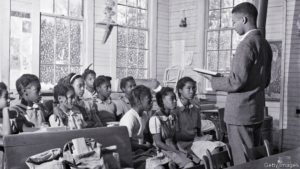 (The Economist) July marks the 55th anniversary of the Civil Rights Act, which outlawed discrimination on the basis of race, colour, religion, sex, or national origin. It also enforced desegregation of the government-run school system nationwide, largely ending the practice of educational apartheid. But while desegregation transformed America’s education system, the way it was implemented by discriminatory school boards in the South was harmful to black teachers. A new paper by Owen Thompson, an economist at Williams College, shows there was a dramatic decline in the employment of African-American teachers in the aftermath of desegregation. The policies behind that decline have contributed to lower employment for African-American educators in the decades since. (more)
(The Economist) July marks the 55th anniversary of the Civil Rights Act, which outlawed discrimination on the basis of race, colour, religion, sex, or national origin. It also enforced desegregation of the government-run school system nationwide, largely ending the practice of educational apartheid. But while desegregation transformed America’s education system, the way it was implemented by discriminatory school boards in the South was harmful to black teachers. A new paper by Owen Thompson, an economist at Williams College, shows there was a dramatic decline in the employment of African-American teachers in the aftermath of desegregation. The policies behind that decline have contributed to lower employment for African-American educators in the decades since. (more)
Texas museum to showcase groundbreaking collection of African-American art
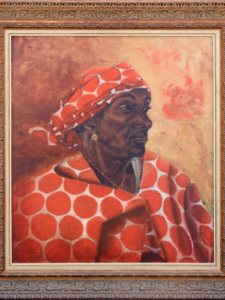
Woman Wearing Orange Scarf, ca. 1940, by Laura Wheeler Waring, Oil on Canvas. (Photo courtesy of African Museum Dallas)
(Culture Map Austin) A groundbreaking exhibition of more than 150 artworks, photos, and rare documents is traveling to Dallas’ African American Museum. “The Kinsey African American Art & History Collection,” celebrating the achievements and contributions of black Americans from 1595 to present time, will be on display September 21-March 1.
The exhibition, considered one of the most comprehensive surveys of African-American history and culture outside the Smithsonian Institution, will feature treasures amassed by Shirley and Bernard Kinsey during their five decades of marriage. The display of paintings and sculpture, photos, rare books, letters, manuscripts, and more has toured 30 cities in the United States and around the world.
According to a release, the exhibition has been cited in three national awards, including the National Medal for Museum and Library Service. (more)
Foundation Consortium Acquires Historic African American Photographic Archive
To Be Donated for Public Benefit and Broadest Possible Access
(Smithsonian) A consortium of foundations – the Ford Foundation, The J. Paul Getty Trust, the John D. and Catherine T. MacArthur Foundation, and the Andrew W. Mellon Foundation – today acquired the archive of Johnson Publishing Company (JPC), publisher of the iconic Ebony and Jet magazines. The acquisition is pending court approval and the closing of the sale.
The archive includes more than 4 million prints and negatives comprising the most significant collection of photographs cataloguing African American life in the 20th century. The archive was acquired for $30 million as part of an auction of the assets of JPC in connection with its Chapter 7 bankruptcy filing.
The foundation consortium will donate the archives to the Smithsonian National Museum of African American History and Culture, the Getty Research Institute, and other leading cultural institutions for the public benefit to ensure the broadest access for the general public and use by scholars, researchers, journalists, and other interested parties. (more)
TIPHC Bookshelf
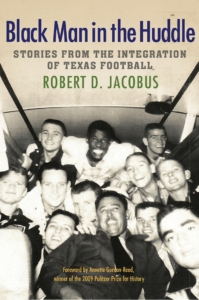 Published scholarship on black history in Texas is growing and we’d like to share with you some suggested readings, both current and past, from some of the preeminent history scholars in Texas and beyond. We invite you to take a look at our bookshelf page – including a featured selection – and check back as the list grows. A different selection will be featured each week. We welcome suggestions and reviews. This week, we offer, “Black Man in the Huddle, Stories from the Integration of Texas Football,” by Robert D. Jacobus.
Published scholarship on black history in Texas is growing and we’d like to share with you some suggested readings, both current and past, from some of the preeminent history scholars in Texas and beyond. We invite you to take a look at our bookshelf page – including a featured selection – and check back as the list grows. A different selection will be featured each week. We welcome suggestions and reviews. This week, we offer, “Black Man in the Huddle, Stories from the Integration of Texas Football,” by Robert D. Jacobus.
“What was it like for young black men growing up in a totally segregated environment and transitioning to an integrated one?” asks author Robert Jacobus in the preface to this collection of interviews. How did they get involved in sports? How did the facilities, both academic and athletic, compare to the white schools? What colleges recruited them out of high school?
Searching for the answers to these and other questions, Jacobus interviewed some 250 former players, former coaches, and others who were personally involved in the racial integration of Texas public school and college athletic programs. Starting with Ben Kelly, the first African American to play for a college team in the former Confederacy when he walked on at then San Angelo College, and continuing with great players such as Jerry Levias, Ken Houston, Mel Renfro, Bubba Smith, and more, the players tell their stories in their own words.
Each story is as varied as the players themselves. Some strongly uphold the necessity of integration for progress in society. Others, while understanding the need for integration, nevertheless mourn the passing of their segregated schools, remembering fondly the close-knit communities forged by the difficulties faced by both students and teachers.
Interlaced with historical context and abundantly illustrated, the first-person accounts presented in Black Man in the Huddle form an important and lasting record of the thoughts, struggles, successes, and experiences of young men on the front lines of desegregation in Texas schools and athletic programs. By capturing these stories, Jacobus widens our perspective on the interactions between sport and American society during the momentous 1950s, ’60s, and ’70s.
This Week in Texas Black History
Jul 28
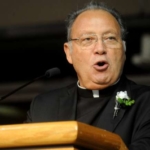 On this date in 2000, Curtis John Guillory was named Bishop of the Catholic Diocese of Beaumont, becoming fifth bishop of the 34-year-old Roman Catholic Diocese of Beaumont and the first African American Catholic bishop in Texas. Guillory was born in Mallet, Louisiana on Sept. 1, 1943, as the oldest of 16 children. He attended Catholic school and entered the seminary of the Society of the Divine Word in Bay St. Louis, Miss., in 1960. He was ordained a priest of the Divine Word Dec. 16, 1972, and he was ordained as the 12th African American bishop in the United States Feb. 19, 1988.
On this date in 2000, Curtis John Guillory was named Bishop of the Catholic Diocese of Beaumont, becoming fifth bishop of the 34-year-old Roman Catholic Diocese of Beaumont and the first African American Catholic bishop in Texas. Guillory was born in Mallet, Louisiana on Sept. 1, 1943, as the oldest of 16 children. He attended Catholic school and entered the seminary of the Society of the Divine Word in Bay St. Louis, Miss., in 1960. He was ordained a priest of the Divine Word Dec. 16, 1972, and he was ordained as the 12th African American bishop in the United States Feb. 19, 1988.
Jul 30
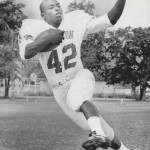 On this day in 1946 Warren McVea was born in San Antonio. McVea was arguably the top high school running back in the country when he graduated from Brackenridge High School in 1964. During his senior season, McVea scored 315 points and 46 touchdowns, which was a single-season record for the University Interscholastic League’s largest school classification (4A). In college, “Wondrous Warren” was the first black player for the University of Houston program and the first to receive a scholarship to a major previously all-white college in Texas. Professionally, he was a fourth-round pick by the Cincinnati Bengals and was a member of the Kansas City Chiefswhen they won Super Bowl IV, defeating the Minnesota Vikings. He was inducted into the San Antonio Sports Hall of Fame in 2003 and the UH Hall of Honor in 2004.
On this day in 1946 Warren McVea was born in San Antonio. McVea was arguably the top high school running back in the country when he graduated from Brackenridge High School in 1964. During his senior season, McVea scored 315 points and 46 touchdowns, which was a single-season record for the University Interscholastic League’s largest school classification (4A). In college, “Wondrous Warren” was the first black player for the University of Houston program and the first to receive a scholarship to a major previously all-white college in Texas. Professionally, he was a fourth-round pick by the Cincinnati Bengals and was a member of the Kansas City Chiefswhen they won Super Bowl IV, defeating the Minnesota Vikings. He was inducted into the San Antonio Sports Hall of Fame in 2003 and the UH Hall of Honor in 2004.
Aug. 1
 On this day in 1948, football and track star Clifford Branch was born in Houston. At Evan E. Worthing High School, Branch was All-District in football (1966), but was also the first schoolboy in Texas history to run the 100-yard dash in 9.3 seconds. He was the state champion in the 100-yard dash (1965) and the 220-yard dash (1966). He attended the University of Colorado where he was an All-American wide receiver (1971) and the 1972 NCAA 100-meter champion with a record time of 10.0. Branch was selected in the fourth round of the National Football League Draft by the Oakland Raiders and played his entire pro career (1972-85) with the team, including three Super Bowl titles. He was named first-team All-Pro three times and finished his career with 501 receptions for 8,685 yards and 67 touchdowns. He is a member of the Prairie View Interscholastic League Hall of Fame.
On this day in 1948, football and track star Clifford Branch was born in Houston. At Evan E. Worthing High School, Branch was All-District in football (1966), but was also the first schoolboy in Texas history to run the 100-yard dash in 9.3 seconds. He was the state champion in the 100-yard dash (1965) and the 220-yard dash (1966). He attended the University of Colorado where he was an All-American wide receiver (1971) and the 1972 NCAA 100-meter champion with a record time of 10.0. Branch was selected in the fourth round of the National Football League Draft by the Oakland Raiders and played his entire pro career (1972-85) with the team, including three Super Bowl titles. He was named first-team All-Pro three times and finished his career with 501 receptions for 8,685 yards and 67 touchdowns. He is a member of the Prairie View Interscholastic League Hall of Fame.
Aug. 2
Legendary Prairie View A&M football coach William J. “Billy” Nicks was born on this day in 1905 in Griffin, Ga. He attended Morris Brown College in Atlanta where he played football, basketball, baseball, and ran track. Nicks returned to his alma mater as head football coach on three different occasions — 1930-35, 1937-39 and 1941-42. His 1941 team was named black college national champion. Nicks began coaching at Prairie View in 1945 and in 17 years compiled a 127-39-8 record and won eight Southwestern Athletic Conference championships and five black college national championships. He had five undefeated seasons as Prairie View became a black college football power in the 1950s and 1960s. Nicks had a winning record against every SWAC school, including Grambling State and legendary head coach Eddie Robinson. His overall record, for 28 years, was 193-61-21, a winning percentage of .763. Nicks is a member of numerous halls of fame, including the College Football Hall of Fame, NAIA, and the SWAC.
Aug. 2
In 1944, 15 months before he would break Major League Baseball‘s color barrier, the court martial of 2nd Lt. Jackie Robinson was held on this day at Fort Hood in Killeen. On July 6, Robinson had refused to move to the “colored section” in the back of a post bus. Among the several resulting charges against Robinson were conduct unbecoming an officer. The trial lasted four hours and after brief deliberations, a panel of nine officers (one of them black) found Robinson not guilty of all charges. Robinson had been morale officer for the all-black 761st Tank Battalion but, by the trial’s end, the unit had departed for Europe where they would perform heroically with Gen. Patton’s Third Army. Robinson was transferred to Camp Breckinridge, Kentucky, where he coached black athletic teams until his honorable discharge in November 1944. He played the 1945 season with the Negro League Kansas City Monarchs and in October of that year signed to play with the Brooklyn Dodgers and was sent to their top Minor League affiliate, the Montreal Royals. Robinson’s debut as MLB’s first black player came on April 15, 1947, at age 28.
Blog: Ron Goodwin, Ph.D., author, PVAMU history professor
Ron Goodwin is an assistant professor of history at Prairie View A&M University. Even though he was a military “brat,” he still considers San Antonio home. Like his father and brother, Ron joined the U.S. Air Force and while enlisted received his undergraduate degree from Texas Lutheran University in Seguin, Texas. After his honorable discharge, he completed graduate degrees from Texas Southern University. Goodwin’s book, Blacks in Houston, is a pictorial history of Houston’s black community. His most recent book, Remembering the Days of Sorrow, examines the institution of slavery in Texas from the perspective of the New Deal’s Slave Narratives.
Recent Posts
Hidden In Plain Sight
In 1903, W.E.B. Du Bois wrote The Souls of Black Folk in which he claimed: “the problem of the Twentieth Century is the problem of the color-line.” That was 1903. American society is in the last year of the second decade of the twenty-first century, and I wonder if that famous quote still applies. In 1903, Jim Crow dominated every aspect of American life and forced the black community into the shadows. Du Bois used”…(more)
A community under siege: the Summer of 1919
I wonder Is there anybody here who late at midnight sheds briny tears all because you didn’t have no one to help you along the way and oh Lord? And if there’s anyone Lord Let me tell you, let me tell you what I’ve done I’ve achieved to be a fence around me but take me everyday I told him So what Jesus be a fence all around me When I get burned So Jesus…(more)
Submissions wanted
Historians, scholars, students, lend us your…writings. Help us produce the most comprehensive documentation ever undertaken for the African American experience in Texas. We encourage you to contribute items about people, places, events, issues, politics/legislation, sports, entertainment, religion, etc., as general entries or essays. Our documentation is wide-ranging and diverse, and you may research and write about the subject of your interest or, to start, please consult our list of suggested biographical entries and see submission guidelines. However, all topics must be approved by TIPHC editors before beginning your research/writing.
We welcome your questions or comments. Please contact Michael Hurd, Director of TIPHC, at mdhurd@pvamu.edu.

